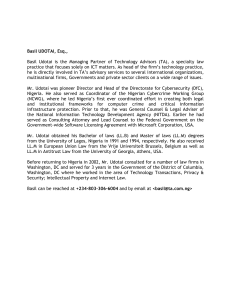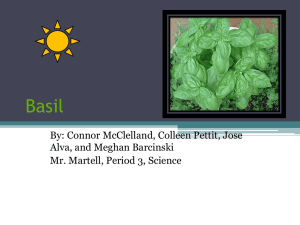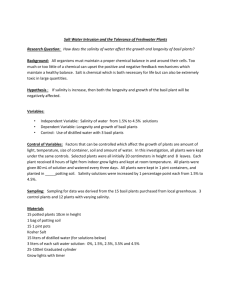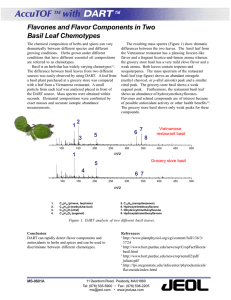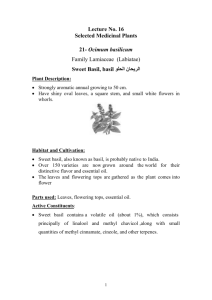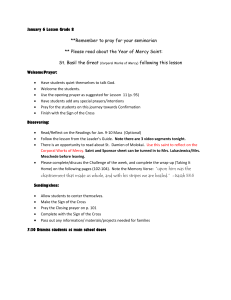Document 14105940
advertisement
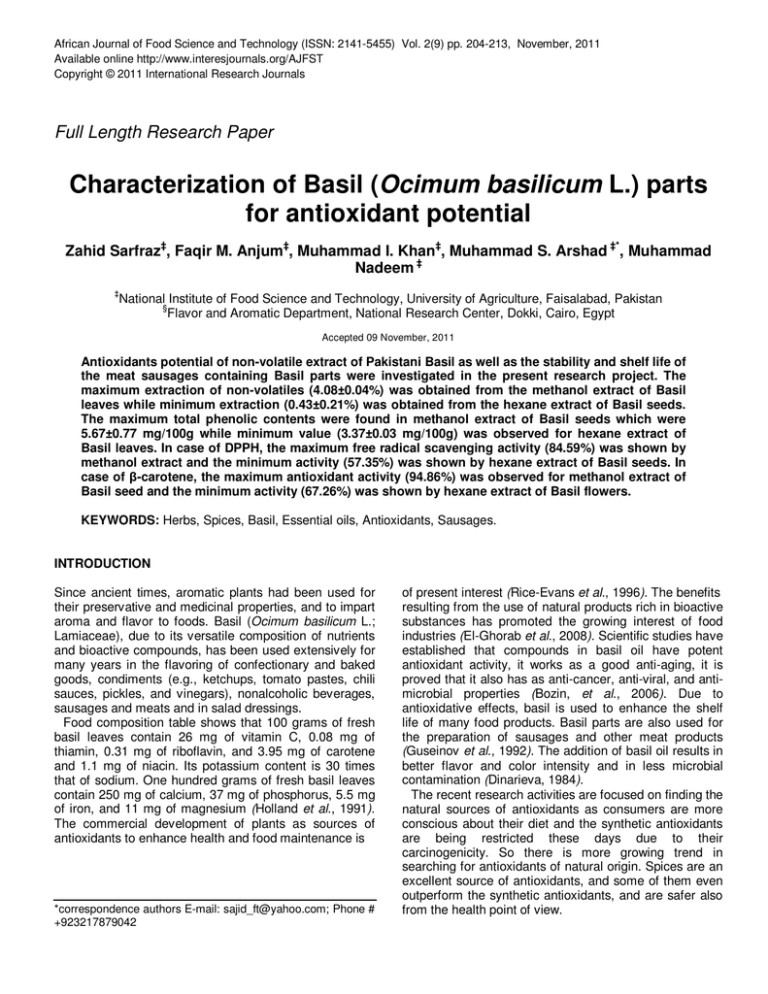
African Journal of Food Science and Technology (ISSN: 2141-5455) Vol. 2(9) pp. 204-213, November, 2011 Available online http://www.interesjournals.org/AJFST Copyright © 2011 International Research Journals Full Length Research Paper Characterization of Basil (Ocimum basilicum L.) parts for antioxidant potential Zahid Sarfraz‡, Faqir M. Anjum‡, Muhammad I. Khan‡, Muhammad S. Arshad ‡*, Muhammad Nadeem ‡ ‡ National Institute of Food Science and Technology, University of Agriculture, Faisalabad, Pakistan § Flavor and Aromatic Department, National Research Center, Dokki, Cairo, Egypt Accepted 09 November, 2011 Antioxidants potential of non-volatile extract of Pakistani Basil as well as the stability and shelf life of the meat sausages containing Basil parts were investigated in the present research project. The maximum extraction of non-volatiles (4.08±0.04%) was obtained from the methanol extract of Basil leaves while minimum extraction (0.43±0.21%) was obtained from the hexane extract of Basil seeds. The maximum total phenolic contents were found in methanol extract of Basil seeds which were 5.67±0.77 mg/100g while minimum value (3.37±0.03 mg/100g) was observed for hexane extract of Basil leaves. In case of DPPH, the maximum free radical scavenging activity (84.59%) was shown by methanol extract and the minimum activity (57.35%) was shown by hexane extract of Basil seeds. In case of β-carotene, the maximum antioxidant activity (94.86%) was observed for methanol extract of Basil seed and the minimum activity (67.26%) was shown by hexane extract of Basil flowers. KEYWORDS: Herbs, Spices, Basil, Essential oils, Antioxidants, Sausages. INTRODUCTION Since ancient times, aromatic plants had been used for their preservative and medicinal properties, and to impart aroma and flavor to foods. Basil (Ocimum basilicum L.; Lamiaceae), due to its versatile composition of nutrients and bioactive compounds, has been used extensively for many years in the flavoring of confectionary and baked goods, condiments (e.g., ketchups, tomato pastes, chili sauces, pickles, and vinegars), nonalcoholic beverages, sausages and meats and in salad dressings. Food composition table shows that 100 grams of fresh basil leaves contain 26 mg of vitamin C, 0.08 mg of thiamin, 0.31 mg of riboflavin, and 3.95 mg of carotene and 1.1 mg of niacin. Its potassium content is 30 times that of sodium. One hundred grams of fresh basil leaves contain 250 mg of calcium, 37 mg of phosphorus, 5.5 mg of iron, and 11 mg of magnesium (Holland et al., 1991). The commercial development of plants as sources of antioxidants to enhance health and food maintenance is *correspondence authors E-mail: sajid_ft@yahoo.com; Phone # +923217879042 of present interest (Rice-Evans et al., 1996). The benefits resulting from the use of natural products rich in bioactive substances has promoted the growing interest of food industries (El-Ghorab et al., 2008). Scientific studies have established that compounds in basil oil have potent antioxidant activity, it works as a good anti-aging, it is proved that it also has as anti-cancer, anti-viral, and antimicrobial properties (Bozin, et al., 2006). Due to antioxidative effects, basil is used to enhance the shelf life of many food products. Basil parts are also used for the preparation of sausages and other meat products (Guseinov et al., 1992). The addition of basil oil results in better flavor and color intensity and in less microbial contamination (Dinarieva, 1984). The recent research activities are focused on finding the natural sources of antioxidants as consumers are more conscious about their diet and the synthetic antioxidants are being restricted these days due to their carcinogenicity. So there is more growing trend in searching for antioxidants of natural origin. Spices are an excellent source of antioxidants, and some of them even outperform the synthetic antioxidants, and are safer also from the health point of view. Sarfraz et al 205 In Pakistan and in other Asian countries various herbs and spices are being used as natural antioxidant and for flavoring and health point of view. Among that the Basil has much importance due to its versatile uses as herb as well as spice. So, the aim of this work is to investigate the shelf life stability of sausages when parts of Basil (Ocimum basilicum L.; Lamiaceae) are used. MATERIALS AND METHODS Procurement of samples and reagents Fresh Basil leaves, flowers and seeds were obtained from Mushtaq Farm House, Aminpur Bangla Faisalabad, Pakistan. The chemicals and reagents used in this study were n-hexane, methanol, Folin-Ciocalteu reagent, Gallic acid, Anhydrous sodium carbonate, 1,1-diphenyl-2picrylhdrazyl (DPPH), β-carotene, Chloroform, Linoleic acid and Tween 80, which were purchased from sigma, UK. added in it. After that 125 µL of Folin-Ciocalteu reagent was added in it and was given a stand of 6 minutes. Then 1.25 mL of 7% sodium carbonate was added in it. Final volume was made 3mL by adding 1mL distilled water. Samples were given a stand for 90 min. for completion of reaction. Then absorbance of the samples was taken in triplicate at 750 nm by using a UV-vis spectrophotometer. Gallic acid was run as a standard along with the samples. Its solution was prepared by taking 25 mg gallic acid and dissolved in 25 mL distilled water. Concentrations of gallic acid ranging from 0 to 450 µg/ mL were used and its standard curve was used for the calculation of the total phenolic contents in the samples. Determination of free radical scavenging activity /antioxidant activity The free radical scavenging activity of basil extracts (nonvolatile) was measured by spectrophotometer at 517 nm as reported by Kim et al. (Kim et al., 2005). Antioxidant activity was also determined by β-carotene method using spectrophotometer at 470 nm by following the method of Hinneburg et al. (2006). Chemical analysis of Basil parts The samples of Basil leaves, flowers and seeds were analyzed for various chemical characteristics like the moisture, fat, ash and protein contents according to their respective methods as given in AOAC. Extraction of non-volatile compounds The non-volatile compounds were extracted by solvent extraction method (El-Ghorab et al., 1999). Weighed amount of samples were taken in flask and the flask was filled with the solvent (n-hexane/ methanol) until a layer was formed above the sample. These samples were continuously shaken for 48 hours with the 3 hour interval. Then these were filtered by filter paper and the extract obtained was subjected to rotary evaporation for the removal of solvent from the samples. After rotary evaporation the samples were taken in petri dishes and the small amount of solvent remaining in the samples was evaporated by placing the samples in the open air. After complete removal of the solvent, the samples were stored in freezer to avoid loss of antioxidant compounds and for further analysis. Total phenolic content (TPC) determination The total phenolic compounds were estimated by FolinCiocalteu method (Sun et al., 2007). From a known concentration of the sample solution 125 µL of sample was taken in test tube. Then 500 µL distilled water was Preparation of Food Model System The beef sausages were prepared by using different concentration of Basil parts while all other ingredients in equal amounts i.e. Beef (1 Kg), Salt (20g), Black pepper (12g), Gram powder (10g), Monosodium Glutamate (1g) and Sodium Nitrate (0.1g) as reported by Sallama et al. (2004). Only basil leaves and flowers were used in sausages production because they were found best for antioxidant potential and also because of hard structures of basil seeds they were not used in sausages production. The sausages were stored at refrigeration temperature (4 ºC) and freezing temperature for 28 days. Following treatments were used; Assessment of lipid oxidation Measurement of TBA value The 2-thiobarbituric acid (TBA) assay was carried out according to the procedure of Schmedes and Holme (1989). Sausages sample (10 g) was mixed with 25 ml of trichloroacetic acid solution and homogenized in a blender for 30s. After filtration, 2 ml of the filtrate was added to 2 ml TBA solution in a test tube. The test tube was incubated at room temperature in the dark for 20h, and then the absorbance was measured at 532 nm by Using UV–VIS spectrophotometer. TBA value was 206 Afr. J. Food Sci. Technol. Treatment T1 T2 T3 T4 T5 T6 T7 T8 BHT 0.01 % - Basil leaves 1.5% 3.0% 4.5% - Basil Flowers 1.5% 3.0% 4.5% - Leaves+ Flowers 2.25% + 2.25% Table 1. Proximate Analysis of Basil leaves, flower and seeds Moisture % Crude Protein % Crude Fat % Ash % Basil Leaves Basil Flower Basil seeds 86.35 ± 0.396 4.2 ± 0.177 0.2 ± 0.014 2.1 ± 0.071 80.5 ± 0.007 3.3 ± 0.092 0.8 ± 0.049 1.5 ± 0.057 5.20 ± 0.042 11.4 ± 0.325 20.2 ± 0.389 6.3 ± 0.247 The results are presented as Mean ± Standard Deviation (SD) expressed as mg malonaldehyde per kg of sausages. Statistical Analysis Peroxide value Data was presented as Mean + Standard Deviation. ANOVA and LSD tests were used to test the significance of results by using Statistix 8.1 software. Peroxide value (POV) was determined according to the procedure prescribed in AOAC. The sample (3 g) was weighed in a 250-ml glass stoppered Erlenmeyer flask and heated in a water bath at 60°C for 3 min to melt the fat, then thoroughly agitated for 3 min with 30 ml acetic acid–chloroform solution (3: 2 v/v) to dissolve the fat. The sample was filtered under vacuum through Whatman filter paper to remove meat particles. Saturated potassium iodide solution (0.5 ml) was added to the filtrate. The titration was allowed to run against standard solution of sodium thiosulfate. POV was calculated and expressed as Meq. Peroxide per kg of sample. pH measurement The sausages were analyzed for pH according to the method described in AOAC. For determination of the pH, 10 g of samples were homogenized with 50 ml distilled water and pH value was measured by a digital pH meter. Sensory evaluation The sensory evaluations of sausages were carried out by a panel of seven judges by following nine point hedonic scales after 7 days as described by Land and Shepherd (1988). RESULTS AND DISCUSSIONS Chemical composition of Basil parts Results regarding proximate composition of different Basil parts are presented in Table 1. The results showed that the moisture content of basil leaves and flowers is very high as compared to the seeds. The basil leaves showed the highest moisture content which was 86.35±0.39. This high moisture content may be due to the difference in climatic and storage conditions. Basil seed showed the lowest moisture content (5.20±0.04%) because its seeds retain less moisture. Protein content is important for nutritional point of view. The protein content of samples of Basil leaves and flowers were 4.2±0.17% and 3.3±0.09% respectively on weight basis. The reason is high moisture content of our samples which significantly lower the other constituents. Basil seeds showed crude protein content of 11.4±0.32%. The crude fat content of the Basil seed was 20.2±0.38% which was almost same as reported by other scientists (Malik et al., 1989). They reported that Basil seed contains fat contents about 21.4%. While Basil leaves and flowers have very less amount of fat content i.e. 0.2 ± 0.01% and 0.8%±0.04 respectively. In case of ash content Basil Sarfraz et al 207 Hexane Basil Leaves 4.5 4 3.5 3 2.5 Methanol Basil Seeds Hexane Basi l Flower 2 1.5 1 0.5 0 S er ies1 Methanol Basil Flower Hexane Basi l Seeds Methanol Basi l Leaves Figure 1. Extraction yield of basil leaves, flowers and seeds with different organic solvents Total Phenolic Contents (mg/g) 7 6 5 4 3 2 1 0 Hexane Basil Leaves Hexane Basil Flower Hexane Methanol Basil Seeds Basil Leaves Methanol Methanol Basil Basil Seeds Flower Extraction Type Figure 2. Total phenolic contents of hexane and methanol extracts of Basil leaves, flower and seeds seeds showed highest value i.e. 6.3±0.24% while Basil leaves and Basil flowers have very less amount of ash content i.e. 2.1±0.07 and 1.5±0.05% respectively. Extraction of non-volatile compounds The percent yield of non-volatile extracts on weight/weight (w/w) basis has been depicted in Fig 1. It is evident that the methanol extracts have higher yield as compared to the n-hexane extracts. The methanol extract of Basil leaves were observed with highest yield (4.08±0.04), while n-hexane extract of Basil leaves showed the lowest yield (0.92±0.03). The results showed that the Basil parts have more polar compounds than that of non polar, because methanolic extract have greater yield. The yield of hexane extract of Basil flowers was 0.85±0.05. In case of methanolic extract it was 2.52±0.08. The increased percentage was due to the polar compounds present in Basil flowers. Basil seeds showed the lowest extraction yield. In case of methanolic extract it was more than that of hexane extract. The extraction yield directly indicates the antioxidant potential of the sample (Loughrin, et al., 2001). There is a high difference between the methanolic extraction yield and hexane yield. The extraction yield also indicates about those 208 Afr. J. Food Sci. Technol. Methanol n-Hexane Inhibition (%) 120 100 80 60 40 20 0 Basil Leaves Basil Flower Basil Seeds Basil Leaves DPPH Basil Flower Basil Seeds β-Carotene Antioxidant Activities Figure 3. Antioxidant activities (DPPH and β-carotene) of Basil leaves, flower and seeds. compound present in sample which are polar or non polar. The more the yield, more will be its scavenging activity. The extraction yield also showed that the methanol extracts dissolved all the polar and hexane dissolved all the non polar compounds of the Basil parts like leaves, flowers and seeds. phenolic contents have higher antioxidant activity (Kahkonen, M.P et al., 1999). A significant correlation existed between antioxidant activity and total phenolics, measured by HPLC analysis in some selected herbs, showing that phenolic compounds were the dominant antioxidant compounds (Wojdylo et al., 2007). Total Phenolic Content Antioxidant activity Total phenolic content of the n-hexane and methanol extracts of Basil samples were measured by using Folin’s reagent. The results are presented as mg of gallic acid equivalent (GAE) per gram of dry extract. Fig 2 showed the total phenolic content of all the three samples for nhexane and methanol extracts. It was shown that methanol and n-hexane extracts of Basil leaves had the phenolic contents reached from 3.97±0.14 to 5.67±0.77 and 3.37±0.038 to 4.89±0.81 respectively which agrees with the results of (Lukmanul et al. 2007). It was also observed that methanol extract of Basil seeds had highest total phenolic content that reached 5.67±0.77 mg/g dry extract. Similarly n-hexane extract of Basil seeds also showed high total phenolics which were 4.89±0.81 mg/g dry. These results agree to a previous study in which (Lukmanul et al. 2007) studied the antioxidant activity of the methanol extracts of Basil flowers and estimated its phenolic content which was 2.8±0.02 mg GAE/g dry weight of the sample. A linear correlation of total phenolics to antioxidant activity was also observed in our study. Literature showed that antioxidants activity is directly related to total phenolic contents. It means the sample having the higher total In this study the antioxidant activity of the nonvolatile components of fresh Basil leaves, flowers and seeds of n-hexane and methanol extracts was determined by using DPPH and β-carotene bleaching method. 1, 1-diphenyl-2-picrylhdrazyl activity (DPPH) scavenging The scavenging activity was greatly affected by the concentration and solvents. Fig. 3 showed that methanolic extract of Basil seeds have maximum inhibition effect than that of other methanolic extracts. There is least difference between the leaves and seeds of methanolic extracts. The Basil seeds extract have 84.59% inhibition activity while the leaves have 79.39%. The n-Hexane extracts showed lower inhibition activity; Basil seeds have very less inhibition effect which is 57.35% and the maximum for Basil flowers which is 64.05%. The pair combination shows that maximum inhibition of DPPH activity was for methanolic extract of basil seeds and the lowest for n-hexane extract of basil Sarfraz et al 209 Table 2. Means for TBA value of sausages at refrigeration temperature Treatment T1 BHT T2 T3 T4 T5 T6 T7 T8 Mean Storage Intervals 7 days 0.14n 0.29ijk 0.30ghij 0.32defg 0.25l 0.27kl 0.29ijk 0.32defg 0.27d 14 days 0.16n 0.30ghij 0.32efgh 0.33cde 0.28jk 0.29ijk 0.30hijk 0.35bcd 0.29c Mean 21 days 0.18m 0.30hijk 0.33cdef 0.35gc 0.30ghij 0.31fgh 0.31fghi 0.35ab 0.30b 28 days 0.21m 0.36g 0.35bc 0.37ab 0.32efgh 0.32efgh 0.32efgh 0.39a 0.33a 0.17f 0.31c 0.32b 0.34a 0.29e 0.30de 0.30cd 0.36a Means not sharing the same letter in a column are significantly different from each other seeds. Basil leaves of n-hexane extract have intermediate scavenging effect which is 61.91%. Interaction of Basil parts and solvents was also significant. The inhibition was attained by the fresh Basil leaves sample which was 82.46% when concentration of sample 200 µg/mL was used. The low inhibition percentage of the Basil leaves sample was 61.91% when 50 µg/mL concentration was used. This may be due to the oxidation of some antioxidant compounds of the extracts or may be due to the low concentration of the extract. The Basil seeds of methanol extract showed higher scavenging effect (85.89%) when concentration of sample 200µg/mL was used and the lowest scavenging effect (57.35%) was observed at concentration of 100µg/mL in hexane extract. seeds and the lowest of methanolic extract and the lowest for Basil seeds of n-hexane extract. Basil flowers of n-hexane extract have intermediate scavenging effect which is 73.01%. Results also showed that the mean value of methanol extracts has greater inhibition effect than the mean value of n-hexane extracts. There is almost 20% difference was observed between them. The β-carotene bleaching mechanism is a free radicalmediated phenomenon, resulting from hydroperoxides formed from linoleic acid. In this study, β-carotene undergoes rapid discoloration due to the attack of free radicals formed upon abstraction of a hydrogen atom from the diallylic methylene group of linoleic acid. The presence of an antioxidant in the reaction mixture hinders the rate of bleaching by neutralizing free radicals formed in the system during incubation at 50°C (Wettasinghe et al., 1999). β-carotene bleaching assay The antioxidant activity was also determined by using βcarotene bleaching assay. Both the n-hexane and methanol extracts were used at the same concentration level 50-200 µg/mL for the determination of antioxidant activity by using β-carotene bleaching assay. Results showed that solvent have significant effect upon βcarotene bleaching, and furthermore the combined effect of variety and solvent have also significant effect on the inhibition of free radicals. Fig 4 shows that methanolic extract of Basil seeds have maximum inhibition effect than that of other methanolic extracts. Least difference was observed between the methanolic extracts of leaves and seeds. The Basil seeds extract have 94.86 % inhibition activity while the leaves have 89.54%. The n-hexane extracts showed lower inhibition activity, Basil seeds showed very less activity (67.26%) and the maximum for Basil leaves which was 75.29%.The pair combination shows that maximum inhibition of β-carotene inhibition activity was for Basil Assessment of lipid oxidation TBA value of sausages at refrigeration temperature Sausages containing BHT produced least amounts of TBA (Table 2) products 0.14 when the sample having BHT stored for 7 days. Among Basil leaves treatments T2 gave best results (0.36) after 28 days storage period, while among sausages containing Basil flowers showed the good result in treatments T7 after 28 days storage period gave maximum TBA value which was 0.32. Storage has profound effect on TBA value and it increased with increase in storage and least TBA value was observed and while maximum TBA value was obtained at 28 days of storage. Interactive effects revealed that in TBA value samples with BHT ranged from 0.14 to 0.21. In T1 TBA value increased from 0.14 to o.21 and these trends were statistically alike in T2 while T8 showed better performance throughout the storage 210 Afr. J. Food Sci. Technol. Table 3. Means for TBA value of sausages at refreezing temperature Treatment T1 BHT T2 T3 T4 T5 T6 T7 T8 Mean Storage Intervals Mean 7 days 14 days 21 days 28 days 0.14p 0.31jkl 0.31jkl 0.34fghi 0.25l 0.27kl 0.29ijk 0.34efgh 0.28d 0.15p 0.32hijk 0.32hij 0.33cde 0.28jk 0.29ijk 0.32hijk 0.37cde 0.30c 0.18o 0.32ijkl 0.33cdef 0.37bcd 0.32hij 0.33ghij 0.34fghi 0.39abc 0.32b 0.21n 0.37cde 0.37cd 0.40a 0.34fghi 0.34fghi 0.36def 0.40ab 0.35a 0.17d 0.33b 0.34b 0.36a 0.31c 0.31c 0.33b 0.37a Means not sharing the same letter in a column are significantly different from each other Table 4. Means for peroxide values of sausages containing Basil leaves and flowers stored at refrigeration temperature Treatment Storage Intervals T1 BHT T2 T3 T4 T5 T6 T7 T8 Mean 7 days 5.63 k 5.63 k 5.63 k 5.63 k 5.63 k 5.63 k 5.70 k 5.70 k 5.65 d 14 days 9.40 j 9.53 ij 10.46 hi 9.60 ij 9.40 j 9.40 j 10.26 hij 10.66 h 9.84 c Mean 21 days 13.13 g 13.93 fg 14.46 ef 13.60 fg 13.13 g 13.13 g 15.167 de 14.923 e 13.93 b 28 days 16.100 cd 16.967 abc 17.317 ab 16.60 bc 16.100 cd 16.100 cd 16.967 abc 17.69 a 16.31 a 9.065 g 10.01 d 11.96 c 11.35 b 10.56f 11.06ef 12.02 de 12.24a Means not sharing the same letter in a column are significantly different from each other duration and TBA value increased from 0.32 to 0.39. TBA value is routinely used as an index of lipid oxidation in meat products in stores (Raharjo et al., 1993) and the rancid flavor is initially detected in meat products between TBA values of 0.5 and 2.0 (Gray et al., 1987). TBA value of sausages at freezing temperature Sausages containing BHT produced least amounts of TBA products (0.14) when the sample having BHT stored for 7 days. Among Basil leaves, treatments T4 gave maximum results 0.40 (Table 3) after 28 days storage period, while among sausages containing Basil flowers T7 showed the good result after 28 days storage period. Storage showed profound effect on TBA value and it increased with increase in storage, while maximum TBA value was obtained at 28 days of storage. Interactive effects revealed that in TBA value samples with BHT ranged from 0.14 to 0.21. In T2 TBA value increased from 0.31 to 0.37 and these trends were statistically alike in T3 while T8 showed better performance throughout the storage duration and TBA value increased from 0.34 to 0.40. In T4 it was clear that it have greater impact in which Basil leaves were used at 4.5% in beef sausages, and almost same result can be seen in T8 where both leaves and flowers were used at conc. of 2.25% each in beef sausages when they were stored for 28 days. The means of treatments also showed clear picture that the T8 gave better results than that of other treatments. While in the means of days, 28 days storage has profound effect on shelf life stability of sausages. T2 and T3 have the same trend for TBA value which was started from 0.31 and last at 0.37. T5 and T6 also showed the same trend during storage period of time. Peroxide value temperature of sausages at refrigeration The peroxide value is expressed as the milliequivalent of peroxide oxygen combined with one kilogram of fat/oil. Sausages containing BHT produced least amounts of POV products (5.63) when the sample having BHT stored for 7 days (Table 4). Treatments containing basil leaves and flowers results in lower amounts of POV products. Sarfraz et al 211 Table 5. Means for Peroxide values of sausages containing Basil leaves and flowers stored at freezing temperature Treatment T1 BHT T2 T3 T4 T5 T6 T7 T8 Mean Storage Intervals 7 days 5.63 k 5.63 k 5.73 k 5.70 k 5.6 k 5.73 k 5.70 k 5.80 k 5.69 d 14 days 9.50 j 10.30 hij 10.36 hi 10.26 hij 10.03 hij 9.66 ij 10.13 hij 10.66 h 10.11 c c 21 days 13.53 fg 14.20 ef 14.46 de 13.66 efg 13.13 g 13.20 ef 15.16 d 15.16 d 14.19 b Mean 28 days 16.10 c 16.96 ab 17.13 ab 16.60 bc 16.10 c 16.10 c 16.96 ab 17.69 a 16.70 a 11.19 e 11.77 bcd 11.92 abc 11.55 cde 11.21 e 11.42 de 11.99 ab 12.33 a Means not sharing the same letter in a column are significantly different from each other Table 6. Changes in pH value of sausages during storage at refrigeration temperature Treatment T1 BHT T2 T3 T4 T5 T6 T7 T8 Mean Storage Intervals 7 days 14 days 6.35fg 6.24j 6.45b 6.41cd 6.49a 6.35fg 6.40de 6.23jk 6.44b 6.42c 6.48a 6.34g 6.39e 6.19k 6.31i 6.14l 6.41a 6.29b Among Basil leaves treatments T3 gave maximum value 17.317 after 28 days storage period, while among sausages containing Basil flowers showed bad result in treatments T7 after 28 days storage period because it gave maximum POV value which was 16.967. Storage exerts a profound effect on POV value and it increased with increase in storage and least POV value was observed and while maximum POV value was obtained at 28 days of storage. Interactive effects revealed that in POV value samples with BHT ranged from 5.63 to 16.10. In T1 POV value increased from 5.63 to 16.10 and these trends were statistically alike in T2 while T8 showed better performance throughout the storage duration and POV value increased from 5.70 to 17.69. In the present study, POV in all samples were below 25meq of active O2/kg, which is considered as limit of acceptability in fatty foods (Evranuz et al., 1993). Peroxide value of sausages stored at freezing temperature Very little variations were observed between the results of refrigeration (Table 4) and freezing (Table 5) storage of sausages for peroxide value. Sausages containing BHT produced least amounts of POV products (5.63) when the sample having BHT stored for 7 days. The highest 21 days 6.13m 6.35fg 6.22jk 6.11n 6.36f 6.22k 6.09o 5.81t 6.16c 28 days 5.91r 6.32h 6.05p 5.89s 6.23jk 6.12m 5.96q 5.47u 5.99d Mean 6.15e 6.38a 6.27d 6.15e 6.36b 6.29c 6.15e 5.93f amount of POV were observed in sausages containing basil leaves in treatment T3 which was 17.317 and results in lower amounts of POV in treatment T3 after 7 days storage. In case of Basil flowers the maximum peroxide value was in the treatment T7 which was 16.96 after the 28 days of storage period. But in the treatment T8 in which both Basil leaves and flowers was present gave good result which was 17.697 after 28 days. But there is intermediate effect of the treatment of T2 and T5. Storage had profound effect on POV value and it increased with increase in storage and least POV value was observed while maximum POV value was obtained at 28 days of storage. Interactive effects revealed that in POV value samples with BHT ranged from 5.63 to 16.10. In T1 POV value increased from 5.63 to 16.10 and these trends were statistically alike in T2 while T8 showed good performance throughout the storage duration and POV value increased from 5.80 to 17.69. Change in pH values of sausages stored at refrigeration temperature The pH values of sausages which were refrigerated vary with concentration of the natural phytochemicals (Table 6). The data showed the highest pH (6.48) in T 6 when a concentration of 3.0% Basil flowers is used in 212 Afr. J. Food Sci. Technol. Table 7. Changes in pH value of sausages during storage at freezing temperature Treatment T 1 BHT T2 T3 T4 T5 T6 T7 T8 Mean Storage Intervals 7 days 6.29fg 6.38b 6.43a 6.34de 6.38b 6.42a 6.33e 6.25i 6.41a 14 days 6.18j 6.35cd 6.29fg 6.17jk 6.36c 6.28g 6.13k 6.08l 6.29b 21 days 6.07m 6.29fg 6.16jk 6.05n 6.30f 6.16k 6.03o 5.75t 6.16c 28 days 5.85r 6.26h 5.99p 5.83s 6.17jk 6.06m 5.90q 5.41u 5.99d Mean 6.15e 6.32a 6.21d 6.09e 6.30b 6.23c 6.09e 5.87f Means not sharing the same letter in a column are significantly different from each other Table 8. Table of means for sensoric attributes of sausages containing Basil leaves and flowers T1 T4 T8 Color 6.67±0.52 8.00±0.00 8.00±0.63 Flavor 6.50±0.84 7.00±0.89 7.17±0.41 Taste 6.83±0.75 6.67±0.52 7.17±0.41 Overall acceptability 7.00 ± 0.00 7.50 ± 0.84 7.83 ± 0.41 Values are presented as Mean+ Standard Deviation sausages and the lowest pH was 5.47 in T 8 when the combination of both Basil leaves and flowers at a concentration of 2.25% each is used. In T 3 and T 6 the trend of decreasing pH value was almost same. Means of days also had decreased trend as the storage period increased. The decrease in pH during storage showed that the stability of sausages became increased because less microbial load in the product during low refrigeration temperature and low pH. The means of pH at different days of storage also shows that continuity of decreasing pH or indirectly increase the shelf life and storage stability. The lowering of pH during storage of sausages increase the shelf life as agreed by Ahn et al.(2002). Change in pH values of sausages stored at freezing temperature The pH values of sausages at freezing temperature containing Basil leaves, flowers and their combination are given in Table 7. The pH values of sausages which were freezed vary with concentration of the natural antioxidants. The data showed, the highest pH (6.42) can be seen in T 6 when a concentration of 3.0% Basil flowers is used in sausages after 7 days of storage, and the lowest pH was 5.41 after 28 days of storage when the combination of both Basil leaves and flowers at a concentration of 2.25% each was used. Also there is a significant change in pH when different concentrations of Basil leaves and flowers are used in beef sausages. The pH values were significantly different between the controlled in which BHT is added at concentration of 0.01% and treated samples at different concentration. T 2 and T 5 had same trend in the table or the values of pH were decreasing continuously. It ranged from 6.35 to 5.93. It means during storage the acidic compounds increased, so that’s why pH decreased. Sensorial evaluation Sensorial evaluation is one of most important part of research in the domain of food science and technology. Product development or acceptability indices are measured to draw certain conclusion for their launching in the consumer market. Beef sausages were prepared using two best treatments and control with BHT. Means for main effects for all sensoric attributes are presented in the table 8. It is evident from the results that color and flavor were significantly affected with Basil parts, while rest of parameters was not affected with the treatments although some differences were there. Color was significantly improved with the application of Basil leaves and flowers in T 8 as compared to BHT. T 4 and T 8 got same scores of 8.00 as compared to 7.33 by control. Taste Sarfraz et al 213 panel observed variation in flavor, taste and color as treatments with extract from Basil leaves and flowers T8 were given maximum scores of 7.17, 7.17 and 7.50 for flavor, taste and color. T 4 came second in the ladder and taste panel awarded them the scores of 7.00, 6.67 and 7.17 for flavor, taste and color while scores of 6.50, 6.83 and 6.67 were awarded to sausages prepared from treatment containing BHT. Overall acceptability as per judgment of taste panel was non-significant as there were statistical similarities for all treatments although scores awarded to T 8 and T 4 were more than control. T 8 got maximum scores (7.83) followed by T 4 (7.50) while control containing synthetic antioxidants got least score (7.00). CONCLUSION Collectively our results emphasize on the chemical composition of different parts of basil cultivated in Pakistan and some variation in their antioxidative potential. In this study we have shown that both Basil flowers and seeds have concentration dependent inhibitory activity towards radical scavenging properties. The results are more potent in leaves of Basil as compared to Basil seeds. Methanol extracts of all the samples were found to have better antioxidant action than the n-hexane extracts. There was also found a good correlation between the total phenolic content and antioxidant activities of the nonvolatile extracts. Our results indicate that the inclusion of both Basil leaves and flowers in the food will increase the content of antioxidants, and thus probably prevent oxidative deterioration of food. So this study concludes that Basil have good antioxidant potential and can be used to produce novel natural antioxidants as well as flavoring agents that can be used in various food products. REFERENCE Ahn J, Grun IU, Fernando LN. (2002). Antioxidant properties of natural plant extract containing polyphenolic compounds in cooked ground beef. J Food Sci. 67: 1364-1369 AOAC. Official methods of analysis of AOAC international (16th Ed.). 1999. Association of official analytical chemists. Gaithersburg MD. USA. Bozin B, Mimica-Dukic N, Simin N, Anackov G. (2006) Characterization of the volatile composition of essential oils of some lamiaceae spices and the antimicrobial and antioxidant activities of the entire oils. J Am Oil Chem Soc. 54(5): 1822–1828. Dinarieva G, Solntseva G, Belusova E, Kandilov N, Shukyurov N, Kocharin A, Guseinov V. (1984) Spice essential oil composition for use in sausage production. USSR Patent, SU1069755A. El-Ghorab A, Fadel H, Marx F, El-Sawy A. (1999) Effect of extraction techniques on the chemical composition and antioxidant activity of Eucalyptus camaldulensis Var. brevirostris leaf oils, Z Lebensm Unters Forsch. 20(8): 212-216. El-Ghorab A, Shaaban HA, El-massry KF, Shibamoto T. (2008) Chemical composition of volatile extract and biological activities of volatile and less volatile extracts of juniper berry fruit, J Agric Food Chem. 56: 5021-5025. Evranuz OE. (1993). The effects of temperature and moisture contenton lipid peroxidation during storage of unblanched salted roasted peanuts: shelf life studies for unblanched salted roasted peanuts. Int J Food Sci Technol. 28: 193–199. Gray JI, Pearson AM. (1987). Rancidity and warmed-over flavor. In A. M. Pearson, & T. R. Dutson (Eds.), Advances in meat research. NY, USA: Van Nostrand Company. pp. 221–269. Guseinov V, Shukyurov N, Movsum-zade A, Ibragimov F, Sadykhova R, Askerova K, Alieva D. (1992) Manufacture of sausages. USSR Patent, SU 1722371. Hinneburg I, Dorman HJD, Hiltunen R. (2006) Antioxidant activities of extracts from selected culinary herbs and spices, Food Chem. 97: 122-129. Holland B, Unwin I, Buss, D, Widdownsonh M. (1991). The Composition of Foods. In: Vegetables, Herbs and Spices, Bath, U.K. p. 205-211. Kahkonen MP, Hopia AI, Vuorela HJ, Rauha JP, Pihlaja K, Kujala TS. (1999) Antioxidant activity of plant extracts containig phenolic compounds, J Agric Food Chem 47: 3954-3962. Kim H, Chen Y, Wang F, Rajapakse Z. (2005) Effect of chitosan on the biological properties of sweet basil, J Am Oil Chem Soc 53: 3696– 3701. Land D, Shepherd R, Scaling and ranking methods. (1988) In: Sensory analysis of foods, J.R. Piggott (ed.), Elsevier applied sciences. New York, pp.155-185. Loughrin JH, Kasperbauer MJ. (2001) Light reflected from colored mulches affects aroma and phenolic content of sweet basil (Ocimum basilicum L.) leaves, J Agric Food Chem 49: 1331-1335. Lukmanul HF, Shankar G, Girija S. (2007) Chemical composition and antioxidant property of holy basil (Ocimum sanctum L.) Leaves, Stems, and Inflorescence and their in vitro callus cultures, J Agric Food Chem 55: 9109-9117. Malik MS, Sattar A, Khan SA. (1989) The fatty acids of indigenous resources from possible industrial applications. Part XVII: The fatty acid composition of the fixed oils of Ocimum basilicum and Ocimum album seeds, Pakistan J Set Ind Res 32: 207–208. Raharjo S, Sofos JN. (1993) Methodology for measuring malonaldehyde as a product of lipid peroxidation in muscle tissues: Meat Sci 35: 145–169. Rice-Evans CA, Miller NJ, Paganga G. (1996). Structure-antioxidant activity relationships of flavonoids and phenolic acids. Free Radical Biol Med 20: 933–956. Sallama KHI, Ishioroshib M, Samejima K. (2004) Antioxidant and antimicrobial effects of garlic in chicken sausage, Lebensm.-Wiss, u.Technol, 37: 849–855. Schmedes A, Holmer G. (1989) A new thiobarbituric acid (TBA) method for determination of free malonaldehyde (MDA) and hydroperoxides selectivity as a measure of lipid peroxidation, J Am Oil Chem Soc 66: 813–817. Sun T, Xu Z, Wu C, Janes M, Prinyawiwatkul W, NO H K. (2007) Antioxidant activities of different colored sweet bell pepper (Capsicum annum L.), J Food Sci 72: 98-102. Wettasinghe M, Shahidi F, Evening F, Meal PR. (1999) A source of natural antioxidants and scavenger of hydrogen peroxide and oxygen derived free radicals, J Agric Food Chem 47: 1801-1812. Wojdylo A, Oszmian J, Czemerys R. (2007) Antioxidant activity and phenolic compoundsin 32 selected herbs, Food Chem 105: 940-949.
